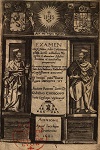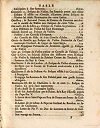Relics of the Chisholm Bishops of Vaison
There were two Chisholm Bishops of Vaison in France at the turn of the sixteenth century - the elder William (II in footnote 2 below) was originally Bishop of Dunblane in Scotland and the younger William (III) was his nephew.
William Chisholm (II) was a member of the family of the Chisholms of Cromlix in Scotland - a family which had produced three Bishops of Dunblane in the sixteenth century (James Chisholm, William Chisholm I and William Chisholm II).
Catholic clergy were forced to flee from Scotland during the Reformation. Many took refuge in France, and tended to stay together in groups.
In 1570 William Chisholm II was appointed to the bishopric of Vaison-la-Romaigne near Avignon, as some recompense for the loss of his position in Scotland and his forced exile.
He cotinued as Bishop of Vaison until 1584, when due to old age he resigned in favour of his nephew William Chisholm III. He retired to the convent of La Grande Chartreuse in Lyon taking the vows of a simple monk, and was later made Prior of Chartreuse and later in Rome.
He continued to busy himself with Scottish affairs until his death in 1593 and is buried in the Church of the Carthusians in Rome.
William III then held office from 1584 until he died in Vaison in 1609. He was aouthor of a book published in 1601.
Four relics exist from their lives in Vaison, a statue of the Bishops, a a book written by William Chisholm III, the stone remnnants of a plaque, and a portrait of William Chisholm III.
There is also a book entitled A History of the Cathedral of Vaison which contains brief biographies of the Bishops.
Hommage aux évêques
 In the village of Crestet near Vaison there is also a small statue built into a small alcove in a private garden.
In the village of Crestet near Vaison there is also a small statue built into a small alcove in a private garden.
Although dated 1580, it is believed to be only from the twentieth century, created in the 1930's by a local sculptor named René Durieux.
On the base of the statue, it is explained that the text is of unknown origin.
"Examination of the Calvinistic Faith" by William Chisholm III
 The cover page of the book contains the title and author:
The cover page of the book contains the title and author:Examen confessionis fides Caluiniana, quam Scotis omnibus ministri Caluiniani
subscribendam et iurandam proponunt :
an rectius, propter inumeras veras fidei detestationes Catholicæ fidei confossionem uocemus,
auctore reueren Dom. D. Gulielmo Cheisolmo, Scoto Episcopo Vasionensi.
The title suggests the book was a Catholic Bishop's commentary on Scottish Protestantism.
There is also a Chisholm boar's head relief on the foot of the cover page.
Stone remnants of a plaque
Vaison is divided into two parts, the upper and lower town, each with a Cathedral.
In the upper town, where William III was Bishop from 1585 to 1629, the remains of his tomb were found a few years ago during renovations of the Cathedral.
The stone remnants of a plaque dedicated to the two Bishops is fixed to the cloister wall in the lower Cathedral.
The plaque is suspected of having been broken during the French Wars of Religion 1562-1598 which ended when religious rights were given to the French Protestant minority.
Portrait of Bishop William Chisholm
The Art and Archealogy Museum of Valence in the Auvergne-Rhone-Alps region of France keeps a portrait in its reserves of Bishop William Chisholm III.
(Unfortunately publication and display of the portrait is currently restricted by the museum)
Footnote 1
History of the Cathedral of Vaison



The History contains biographies of the Bishops Cheisolme.
William II is referred to as Guillaume III Cheisolme I of Vaison and William III as Guillaume IV Cheisolme II of Vaison.
Footnote 2
The Chisholm Bishops of Dunblane in the sixteeenth century.
The following notes are taken from Mackenzie's book History of the Chisholms in the chapter describing The Chisholms of Cromlix and Dundorne.
Sir Edmund Chisholm was the founder of the House of Cromlix in Perthshire. He came to Cromlix in the early fifteenth century, descended from the Chisholmes of Roxburghshire.
In the eighty years preceding the Reformation three Bishops of Dunblane were Chisholms of this Cromlix family.
The eldest son of Edmund Chisholm was named James Chisholm. He held the office of Bishop of Dunblane from 1486 until 1527 when, due to old age, he handed over many of his duties to his half brother William Chisholm (William I), the eldest
son of Edmund's second marriage.
James continued to perform ecclesiastical duties as coadjutor with William until his death in 1534.
William Chisholm I was appointed as the next Bishop of Dunblane and held office from 1534 to 1564.
He was described in historical works as "an ecclesiastic of the wost possible type for fornication, church robbery and persecution of heretics" (including the excommunication of the martyr George Wishart). In 1561 he resigned and by Papal Brief continued as coadjutor with his nephew William Chisholm II until his death in 1564.
In 1564 William Chisholm II was appointed Bishop of Dunblane and held office from 1564 to 1569.
Other historical notes (from Wikipedia) describe how William Chisholm II was spoken of by John Knox as “one of the chief pillars of the Papistical Kirk”. He was often employed by Mary Queen of Scots in diplomatic missions, including one to Rome in 1565
to obtain leave for her to marry her half cousin Henry Stuart, Lord Darnley,
and later on another mission in 1567 to explain the circumstances of her subsequent marriage to James Hepburn, Lord Bothwell.
After the abdication of Mary in 1567 in the throes of the Reformation in Scotland and a widening Protestant Catholic split, many clergy were forced to take refuge on the continent.
In exile in 1569 he was appointed as priest at the Basilica di Santa Maggiore in Rome, and in 1570 was instituted by the Pope to the Bishopric of Vaison-la-Romaine, near Avignon as some recompense for the loss of his position in Scotland and his exile.